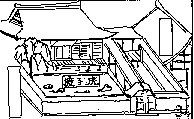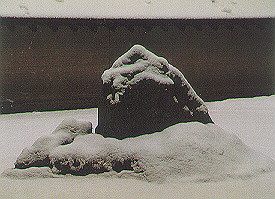
The Chinese character in the middle
reads "Tiger Cubs Crossing the Sea".

The Chinese character in the middle
reads "Tiger Cubs Crossing the Sea".
Traditional Interpretations
Although there were significant changes through the periods, the garden was originally named "Tiger Cubs Crossing the Sea." That remained the most recognized and traditional interpretation. Another simple interpretation of the stone arrangement is that the sand floor symbolizes sea waves, and the rocks symbolize islands. However, most scholars settle for a much simpler yet more profound understanding of the unusual composition.

Other Interpretations
The picture above perfectly illustrates what Loraine Kuck described in her book of the garden. Kuck sees the garden as "sermon in stone", best shown through its harmony and balance. According to Kuck, the garden is best captured in its subliminal and mysterious state in the winter. Other scholars such as Nitschke sees the garden as the epitome of the art of void. He describes how the garden, by representing the minimal, is able to celebrate the void in enabling viewers to turn inward towards one's interior. Treib and Herman agree with Nitschke on the ability of the garden to fill in the imagination of the viewers with its bare landscape.